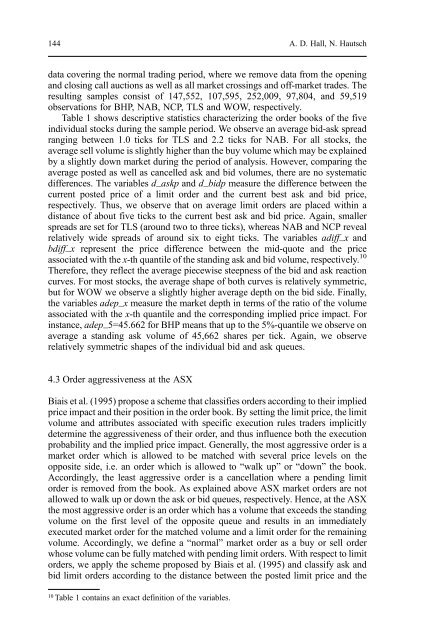recent developments in high frequency financial ... - Index of
recent developments in high frequency financial ... - Index of
recent developments in high frequency financial ... - Index of
Create successful ePaper yourself
Turn your PDF publications into a flip-book with our unique Google optimized e-Paper software.
144<br />
data cover<strong>in</strong>g the normal trad<strong>in</strong>g period, where we remove data from the open<strong>in</strong>g<br />
and clos<strong>in</strong>g call auctions as well as all market cross<strong>in</strong>gs and <strong>of</strong>f-market trades. The<br />
result<strong>in</strong>g samples consist <strong>of</strong> 147,552, 107,595, 252,009, 97,804, and 59,519<br />
observations for BHP, NAB, NCP, TLS and WOW, respectively.<br />
Table 1 shows descriptive statistics characteriz<strong>in</strong>g the order books <strong>of</strong> the five<br />
<strong>in</strong>dividual stocks dur<strong>in</strong>g the sample period. We observe an average bid-ask spread<br />
rang<strong>in</strong>g between 1.0 ticks for TLS and 2.2 ticks for NAB. For all stocks, the<br />
average sell volume is slightly <strong>high</strong>er than the buy volume which may be expla<strong>in</strong>ed<br />
by a slightly down market dur<strong>in</strong>g the period <strong>of</strong> analysis. However, compar<strong>in</strong>g the<br />
average posted as well as cancelled ask and bid volumes, there are no systematic<br />
differences. The variables d_askp and d_bidp measure the difference between the<br />
current posted price <strong>of</strong> a limit order and the current best ask and bid price,<br />
respectively. Thus, we observe that on average limit orders are placed with<strong>in</strong> a<br />
distance <strong>of</strong> about five ticks to the current best ask and bid price. Aga<strong>in</strong>, smaller<br />
spreads are set for TLS (around two to three ticks), whereas NAB and NCP reveal<br />
relatively wide spreads <strong>of</strong> around six to eight ticks. The variables adiff_x and<br />
bdiff_x represent the price difference between the mid-quote and the price<br />
associated with the x-th quantile <strong>of</strong> the stand<strong>in</strong>g ask and bid volume, respectively. 10<br />
Therefore, they reflect the average piecewise steepness <strong>of</strong> the bid and ask reaction<br />
curves. For most stocks, the average shape <strong>of</strong> both curves is relatively symmetric,<br />
but for WOW we observe a slightly <strong>high</strong>er average depth on the bid side. F<strong>in</strong>ally,<br />
the variables adep_x measure the market depth <strong>in</strong> terms <strong>of</strong> the ratio <strong>of</strong> the volume<br />
associated with the x-th quantile and the correspond<strong>in</strong>g implied price impact. For<br />
<strong>in</strong>stance, adep_5=45.662 for BHP means that up to the 5%-quantile we observe on<br />
average a stand<strong>in</strong>g ask volume <strong>of</strong> 45,662 shares per tick. Aga<strong>in</strong>, we observe<br />
relatively symmetric shapes <strong>of</strong> the <strong>in</strong>dividual bid and ask queues.<br />
4.3 Order aggressiveness at the ASX<br />
Biais et al. (1995) propose a scheme that classifies orders accord<strong>in</strong>g to their implied<br />
price impact and their position <strong>in</strong> the order book. By sett<strong>in</strong>g the limit price, the limit<br />
volume and attributes associated with specific execution rules traders implicitly<br />
determ<strong>in</strong>e the aggressiveness <strong>of</strong> their order, and thus <strong>in</strong>fluence both the execution<br />
probability and the implied price impact. Generally, the most aggressive order is a<br />
market order which is allowed to be matched with several price levels on the<br />
opposite side, i.e. an order which is allowed to “walk up” or “down” the book.<br />
Accord<strong>in</strong>gly, the least aggressive order is a cancellation where a pend<strong>in</strong>g limit<br />
order is removed from the book. As expla<strong>in</strong>ed above ASX market orders are not<br />
allowed to walk up or down the ask or bid queues, respectively. Hence, at the ASX<br />
the most aggressive order is an order which has a volume that exceeds the stand<strong>in</strong>g<br />
volume on the first level <strong>of</strong> the opposite queue and results <strong>in</strong> an immediately<br />
executed market order for the matched volume and a limit order for the rema<strong>in</strong><strong>in</strong>g<br />
volume. Accord<strong>in</strong>gly, we def<strong>in</strong>e a “normal” market order as a buy or sell order<br />
whose volume can be fully matched with pend<strong>in</strong>g limit orders. With respect to limit<br />
orders, we apply the scheme proposed by Biais et al. (1995) and classify ask and<br />
bid limit orders accord<strong>in</strong>g to the distance between the posted limit price and the<br />
10 Table 1 conta<strong>in</strong>s an exact def<strong>in</strong>ition <strong>of</strong> the variables.<br />
A. D. Hall, N. Hautsch










